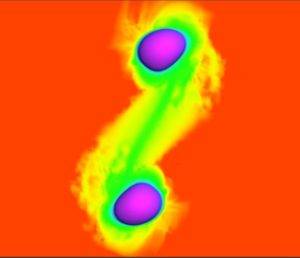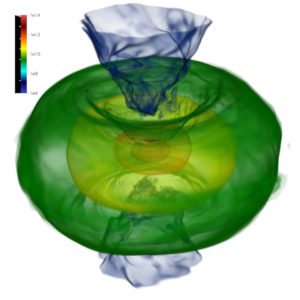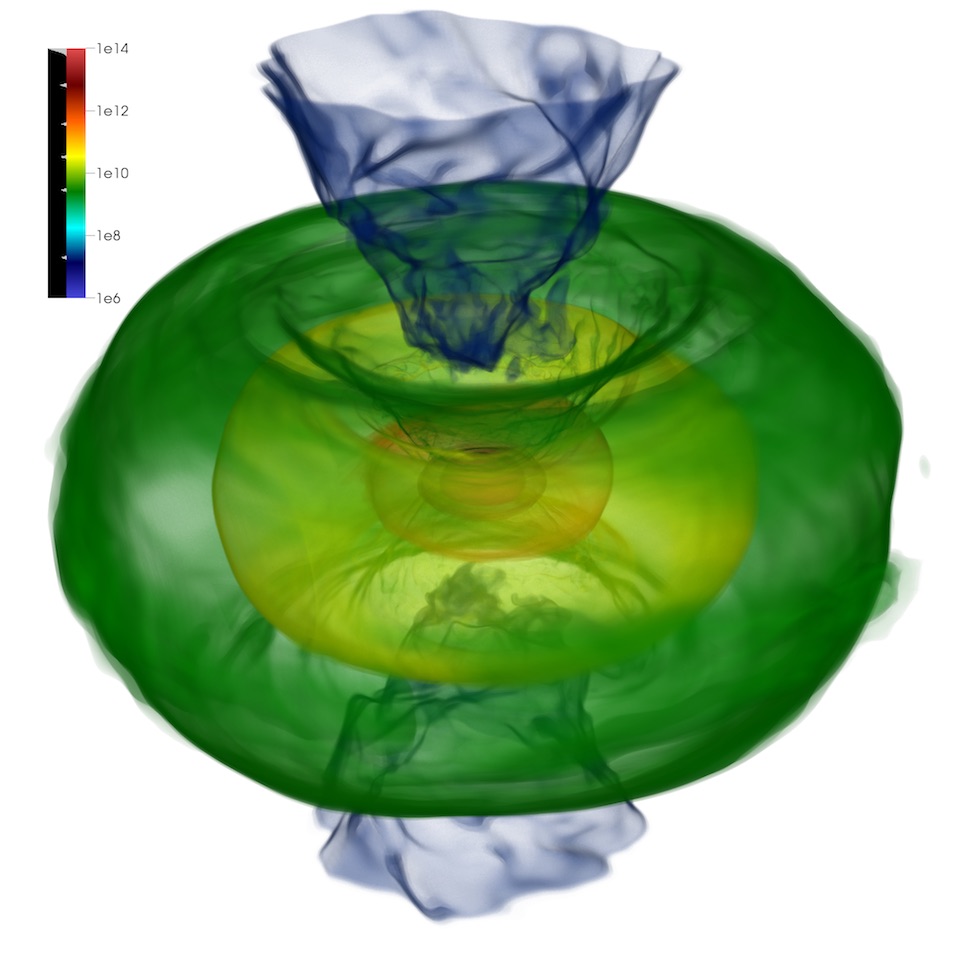Over at XSEDE, Kimberly Mann Bruch & Jan Zverina from the San Diego Supercomputer Center write that researchers are using supercomputers to create detailed simulations of neutron star structures and mergers to better understand gravitational waves, which were detected for the first time in 2015.

This image of an eccentric binary neutron star system’s close encounter is an example of the large surface gravity wave excitations, which are similar to ocean waves found in very deep water. Credit: William East, Perimeter Institute for Theoretical Physics
During a supernova, a single massive star explodes – some die and form black holes while others survive, depending on the star’s mass. Some of these supernova survivors are stars whose centers collapse and their protons and electrons form into a neutron star, which has an average gravitational pull that is two billion times the gravity on Earth.
Researchers from the U.S., Canada, and Brazil have been focusing on the construction of a gravitational wave model for the detection of eccentric binary neutron stars. Using Comet at the San Diego Supercomputer Center (SDSC) and Stampede2 at the Texas Advanced Computing Center (TACC), the scientists performed simulations of oscillating binary neutron stars to develop a novel model to predict the timing of various pericenter passages, which are the points of closest approach for revolving space objects. Their study, Evolution of Highly Eccentric Binary Neutron Stars Including Tidal Effects was published in Physical Review D. Frans Pretorius, a physics professor at Princeton University, is the Principal Investigator on the allocated project.
Our study’s findings provide insight into binary neutron stars and their role in detecting gravitational waves,” according to co-author Huan Yang, with the Perimeter Institute for Theoretical Physics in Waterloo, Ontario, Canada. “We can see that the oscillation of the stars significantly alters the trajectory and it is important to mention the evolution of the modes. For this case, during some of the later close encounters, the frequency of the orbit is larger when this evolution is tracked – compared to when it is not – as energy and angular momentum are taken out of the neutron star oscillations and put back into orbit.”
In other words, probing gravitational waves from eccentric binary neutron stars provides a unique opportunity to observe neutron star oscillations. Through these measurements, researchers can infer the internal structure of neutron stars.
This is analogous to the example of ‘hearing the shape on a drum,’ where the shape of a drumhead can be determined by measuring frequencies of its modes,” said Yang. “By ‘hearing’ the modes of neutron stars with gravitational waves, the star’s size and internal structure will be similarly determined, or at least constrained.”
“In particular, our dynamical space-time simulations solve the equations of Einstein’s theory of general relativity coupled to perfect fluids,” said co-author Vasileios Paschalidis, with the University of Arizona’s Theoretical Astrophysics Program. “Neutron star matter can be described as a perfect fluid, therefore the simulations contain the necessary physics to understand how neutron stars oscillate due to tidal interactions after every pericenter passage, and how the orbit changes due to the excited neutron star oscillations. Such simulations are computationally very expensive and can be performed only in high-performance computing centers.”
XSEDE resources significantly accelerated our scientific output,” noted Paschalidis, whose group has been using XSEDE for well over a decade, when they were students or post-doctoral researchers. “If I were to put a number on it, I would say that using XSEDE accelerated our research by a factor of three or more, compared to using local resources alone.”
Neutron Star Mergers Form the Cauldron that Brews Gravitational Waves
The merger of two neutron stars produces a hot (up to one trillion degrees Kelvin), rapidly rotating massive neutron star. This remnant is expected to collapse to form a black hole within a timescale that could be as short as one millisecond, or as long as many hours, depending on the sum of the masses of the two neutron stars.

The massive neutron star shown in this three-dimensional rendition of a Comet-enabled simulation shows the emergence of a wind driven by neutrino radiation. The star is surrounded by debris expelled during and shortly after the merger. Credit: David Radice, Princeton University
Featured in a recent issue of the Monthly Notices of the Royal Astronomical Society, Princeton University Computational and Theoretical Astrophysicist David Radice and his colleagues presented results from their simulations of the formation of neutron star merger remnants surviving for at least one tenth of a second. Radice turned to XSEDE for access to Comet, Stampede2, and Bridges, which is based at the Pittsburgh Supercomputing Center (PSC).
It has been long thought that this type of merger product would be driven toward solid-body rotation by turbulent angular momentum transport, which acts as an effective viscosity. However, Radice and his collaborators discovered that the evolution of these objects is actually more complex.
We found that long-lived neutron star merger remnants are born with so much angular momentum that they are unable to reach solid body rotation,” said Radice. “Instead, they are viscously unstable. We expect that this instability will result in the launching of massive neutron rich winds. These winds, in turn, will be extremely bright in the UV/optical/infrared bands. The observation of such transients, in combination with gravitational-wave events or short gamma-ray bursts, would be ‘smoking gun’ evidence for the formation of long-lived neutron star merger remnants.”
If detected, the bright transients predicted in this study could allow astronomers to measure the threshold mass below which neutron star mergers do not result in rapid black hole formation. This insight would be key in the quest to understand the properties of matter at extreme densities found in the hearts of neutron stars.
Radice’s research used 35 high-resolution, general-relativistic neutron star merger simulations, which calculated the geometry of space-time as predicted by Einstein’s equations and simulated the neutron star matter using sophisticated microphysical models. On average, one of these simulations required about 300,000 CPU-hours.
My research would not be possible without XSEDE,” said Radice, who has used XSEDE resources since 2013, and for this study collaborated with Lars Koesterke at TACC to run his code efficiently on Stampede2. Specifically, this work was conducted in the context of an XSEDE Extended Collaborative Support Services (ECSS) project, which will be of benefit to future research.
“The cost can be up to a factor of three times higher for the selected models that were run at even higher resolution and depending on the detail level in the microphysics,” added Radice. “Because of the unique requirements of this study, which included a large number of intermediate-size simulations and few larger calculations, a key enabler was the availability of a combination of capability and capacity supercomputers including Comet and Bridges.”
Source: XSEDE




